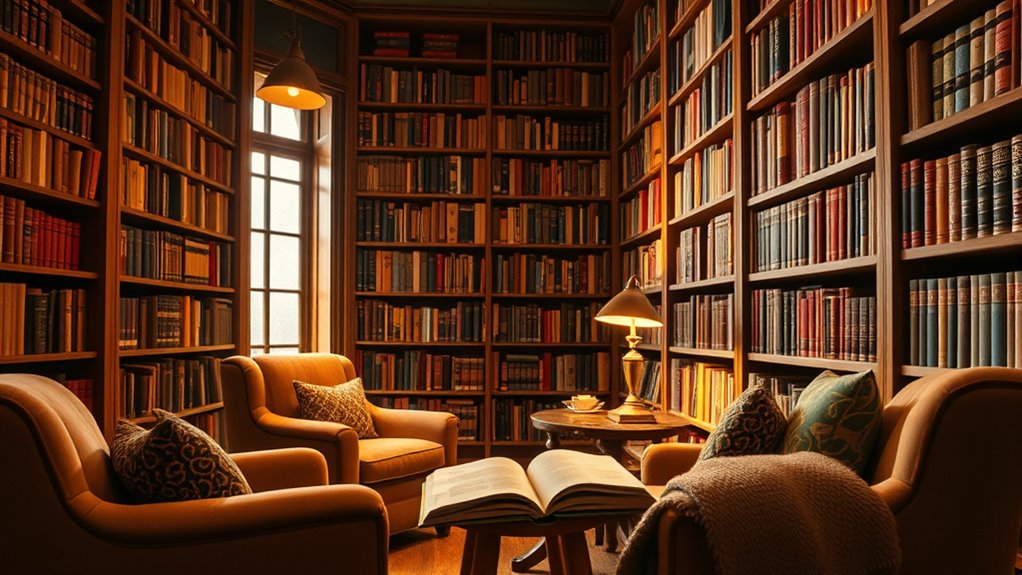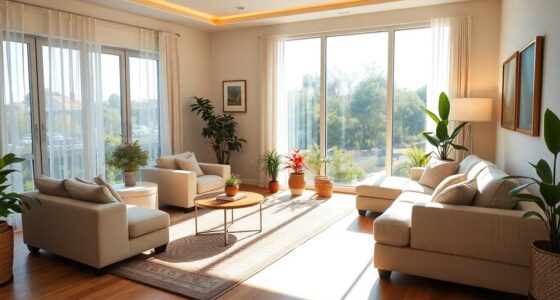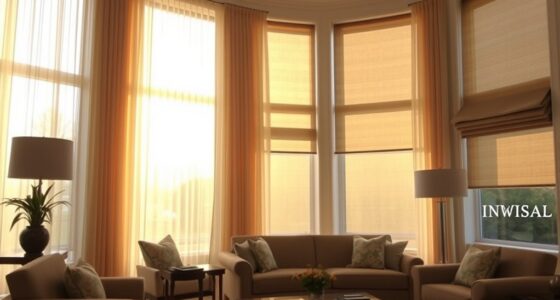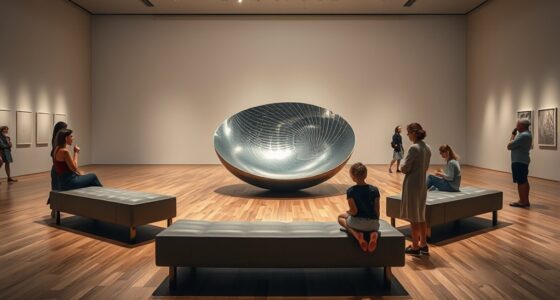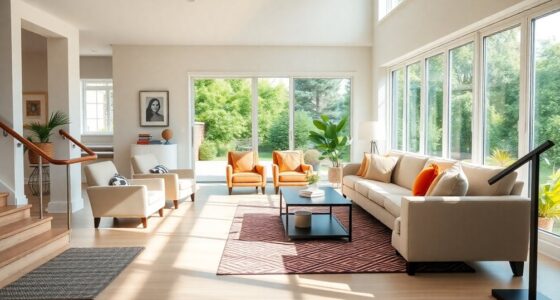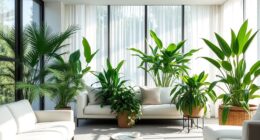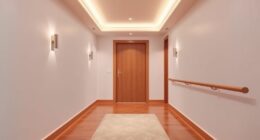To reduce eye strain in your home library or reading nook, choose a quiet spot with natural light, preferably positioned to enjoy sunlight during the day, and add soft, warm artificial lighting at night. Use comfortable furniture, open shelves, and adjustable lamps to create a cozy, clutter-free space that feels inviting. Paying attention to lighting levels and environment details can transform your space into the perfect refuge for relaxed, strain-free moments—if you want to explore more, keep reading.
Key Takeaways
- Choose a quiet, cozy corner with natural light to reduce eye strain during reading sessions.
- Incorporate layered, adjustable lighting like lamps and sconces to minimize glare and shadows.
- Use warm-toned bulbs and dimmer switches for customizable, eye-friendly illumination.
- Keep books within arm’s reach and organize them by genre or size for easy access without strain.
- Personalize the space with soft rugs, plants, and cozy throws to create a calming environment that encourages longer reading.
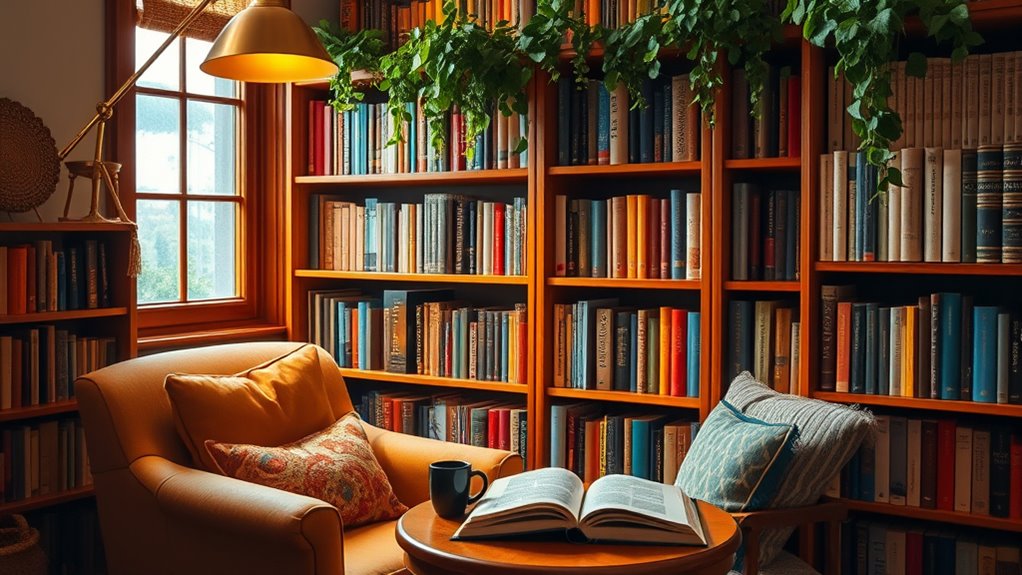
After long hours of screen time or busy days, your eyes deserve a soothing retreat. Creating a cozy home library or reading nook lets you escape into a world of words without straining your eyes. Think of this space as your personal sanctuary—an inviting corner where you can unwind and recharge. To start, choose a quiet spot away from harsh overhead lights or screens. Natural light is your best friend here; it’s gentle on your eyes and creates a warm, welcoming atmosphere. Position your seating so that you can enjoy the sunlight during the day, but also have the option of soft, adjustable lighting for evenings. A comfortable armchair or a plush reading sofa works perfectly, supporting your back and neck so you can settle in for hours without discomfort.
Create a cozy reading nook with natural light and comfortable seating for eye-friendly relaxation.
Next, consider the layout and organization. Keep your books within arm’s reach but avoid clutter that can distract or cause eye strain. Use open shelves or wall-mounted bookcases to free up space and maintain a clean, open feel. When arranging your books, group them by genre or size, making it easier to find what you want without unnecessary searching. Incorporate small tables nearby for your coffee, tea, or reading glasses—small touches that make your space functional and inviting. Adding a soft rug can also help absorb sound and create a cozy atmosphere, encouraging you to linger longer. Choosing appropriate lighting that minimizes glare will further enhance your comfort and protect your eyes during long reading sessions.
Lighting is essential for eye comfort. Besides natural light, invest in layered lighting options like adjustable reading lamps or sconces. Warm-toned bulbs mimic daylight and reduce glare, helping to prevent eye fatigue. Dimmer switches let you tailor the light to your mood or time of day. Avoid harsh fluorescent bulbs or overly bright overhead fixtures that can cause glare and discomfort. Keep lighting at eye level or slightly above your reading spot to avoid shadows and reflections that strain your eyes. Remember, the goal is to create a well-lit environment that feels soothing and easy on your eyes, even during extended reading sessions.
Finally, personalize your space with meaningful accessories—plants, artwork, or cozy throws—that make your library or nook feel inviting. These touches foster a sense of calm and make your retreat a place you look forward to visiting. By thoughtfully designing your home library or reading nook with comfort, organization, and lighting in mind, you give your tired eyes the rest they need. It becomes more than just a space for books; it’s your dedicated escape to relax, rejuvenate, and indulge in the joy of reading without eye strain.
Frequently Asked Questions
What Are the Best Colors for Relaxing Reading Spaces?
You should choose soft, muted colors like warm beige, gentle blues, or calming greens for your relaxing reading space. These hues create a soothing atmosphere that reduces eye strain and promotes comfort. Avoid harsh or overly bright colors, which can be overstimulating. Instead, opt for shades that evoke tranquility, helping you unwind and focus on your book without feeling overwhelmed.
How Can I Reduce Glare on My Reading Lamps?
Think of glare as a pesky butterfly fluttering around your reading space. To tame it, use lamps with adjustable brightness and position them away from reflective surfaces. Choose lampshades that diffuse light softly, preventing harsh reflections. You can also switch to warm-colored bulbs, which reduce eye strain. Adding a matte finish to nearby furniture or walls minimizes reflections, creating a cozy, glare-free haven for your eyes to rest and read comfortably.
What Ergonomic Furniture Is Ideal for Long Reading Sessions?
You should choose ergonomic furniture like adjustable chairs with proper lumbar support and a desk that allows you to maintain good posture. An ergonomic chair with customizable height and armrests helps reduce strain during long reading sessions. Opt for a desk at the right height to keep your neck and shoulders relaxed. Incorporate a footrest if needed, and guarantee your workspace promotes comfort and proper alignment to prevent fatigue.
How Do I Soundproof My Home Library Effectively?
Sure, just shout your secrets to the walls—no need for soundproofing! But if you want real peace, add thick curtains, plush rugs, and acoustic panels. Seal gaps around doors and windows, and consider a white noise machine to drown out distractions. These simple steps make your library a quiet sanctuary, turning “soundproofing” into a cozy haven where you can lose yourself in a book without interruptions.
What Are Eco-Friendly Materials for Building Reading Nooks?
You can use eco-friendly materials like reclaimed wood for shelving and furniture, which reduces waste and deforestation. Bamboo is another sustainable option, as it grows quickly and requires minimal resources. For insulation, opt for recycled cotton or sheep’s wool, both natural and biodegradable. Organic cotton or linen fabrics work well for cushions or curtains. These choices help create a cozy, environmentally conscious reading nook that’s gentle on the planet.
Conclusion
With a cozy home library or reading nook, your tired eyes will thank you for the oasis of comfort you create. Imagine sinking into plush cushions, surrounded by endless shelves of books, and feeling your fatigue evaporate like magic. It’s not just a space; it’s your personal sanctuary from the chaos of the world. So go ahead, build that perfect nook—your tired eyes deserve the royal treatment of a literary paradise, every single day.
